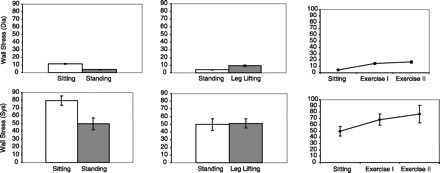Fig. 8.

Calculated (n = 10 students) ventricular systolic and diastolic wall stress are shown for changes in posture (left), during leg lifting (middle), and during exercise (right). The units are omitted. Systolic and diastolic wall stress fall during standing due to a reduction in venous return. Diastolic wall stress increases during an increase in venous return during leg lifting. Both diastolic and systolic wall stress increase during exercise due to increased contractility and increased filling. (It is important to note that a putative ventricular diastolic pressure was provided to the students for calculations, and, because systolic wall stress may occur during isovolumic contraction, we estimated pressure in the ventricle as arterial systolic pressure.)
